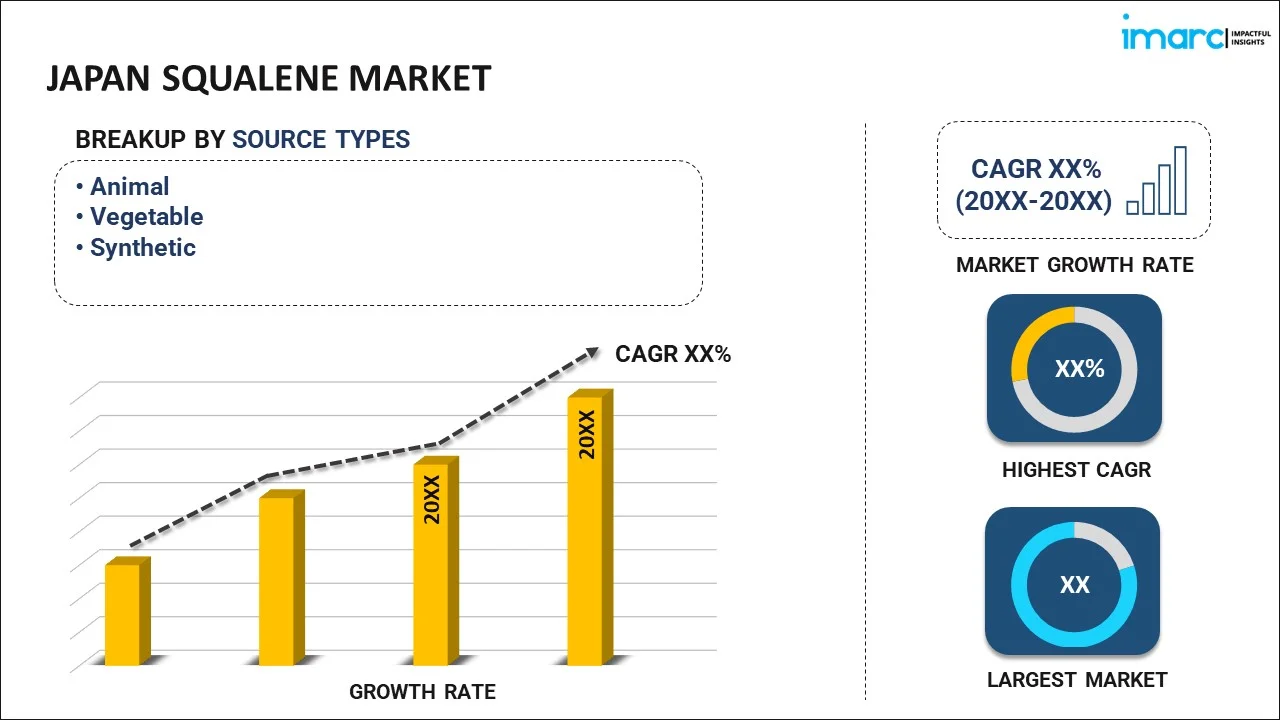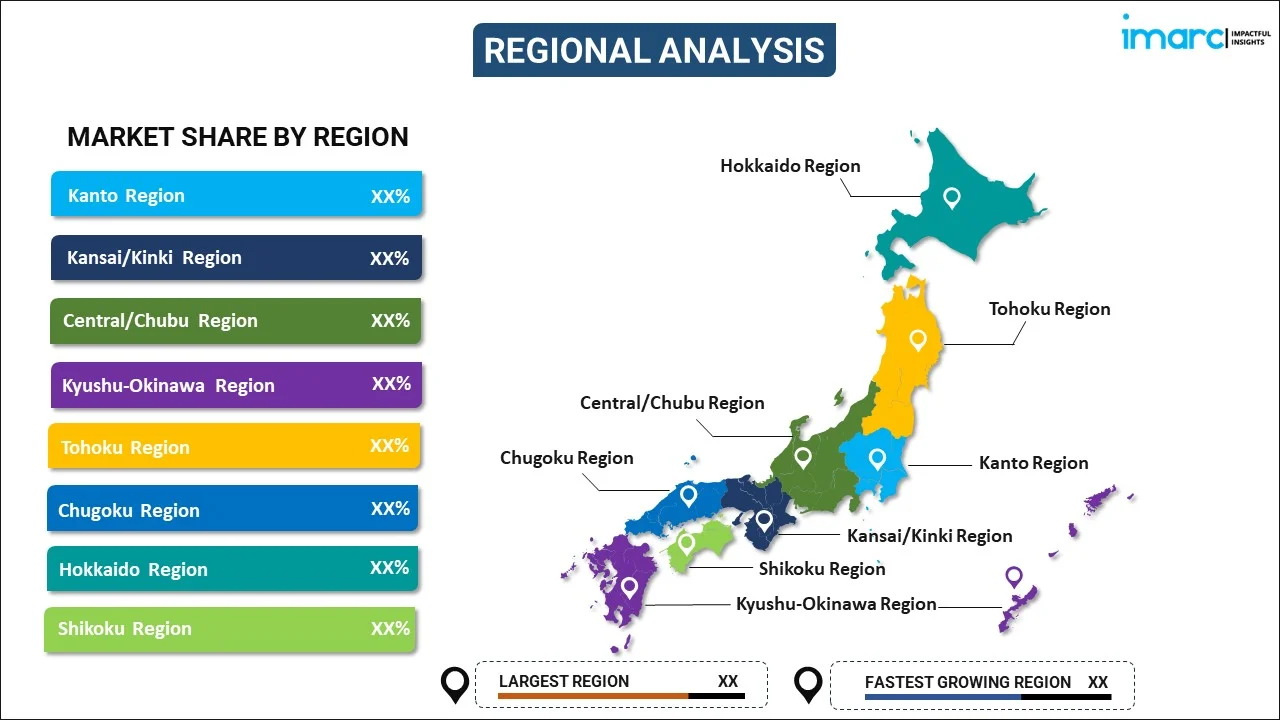
Japan Squalene Market Report by Source Type (Animal, Vegetable, Synthetic), Application (Cosmetics, Food, Pharmaceuticals, and Others), and Region 2025-2033
Market Overview:
Japan squalene market size reached USD 9.2 Million in 2024. Looking forward, IMARC Group expects the market to reach USD 14.7 Million by 2033, exhibiting a growth rate (CAGR) of 5.4% during 2025-2033. The increasing advances in extraction and production technologies that can lead to more efficient and cost-effective methods of obtaining squalene, making it more accessible to various industries, are driving the market.
|
Report Attribute
|
Key Statistics
|
|---|---|
|
Base Year
|
2024 |
|
Forecast Years
|
2025-2033
|
|
Historical Years
|
2019-2024
|
| Market Size in 2024 | USD 9.2 Million |
| Market Forecast in 2033 | USD 14.7 Million |
| Market Growth Rate (2025-2033) | 5.4% |
Squalene is a natural organic compound found in various living organisms, including humans. It is a hydrocarbon derived from the biosynthesis of cholesterol and is a key intermediate in the production of important molecules in the body. Squalene is most commonly associated with its presence in shark liver oil, where it can make up a significant portion of the oil's composition. In skincare and cosmetics, squalene is often used as an emollient and moisturizer due to its excellent hydrating properties. It helps to maintain the skin's moisture balance and can leave the skin feeling soft and smooth. Olive oil is another source of squalene, and it is often used in some cosmetic products as a plant-based alternative to shark-derived squalene. Squalene has also gained attention in the field of vaccine development, where it is used as an adjuvant to enhance the effectiveness of certain vaccines by boosting the body's immune response.
Japan Squalene Market Trends:
Several key factors are driving the growth of the squalene market in Japan. Firstly, the rising demand for squalene in the cosmetics and personal care industry is a significant driver. Squalene's exceptional moisturizing and skin-rejuvenating properties have made it a sought-after ingredient in skincare products, contributing to its market expansion. In addition to this, the growing awareness of the health benefits associated with squalene consumption has boosted its demand in the pharmaceutical and dietary supplement sectors. Moreover, the regional trend towards natural and organic products has spurred interest in squalene, as it is often derived from sustainable sources such as olive oil and shark liver. This eco-friendly image aligns with the increasing consumer preference for environmentally responsible products. Furthermore, technological advancements in squalene extraction and production processes, which have enhanced its availability and affordability, are expected to drive the squalene market in Japan during the forecast period.
Japan Squalene Market Segmentation:
IMARC Group provides an analysis of the key trends in each segment of the market, along with forecasts at the country level for 2025-2033. Our report has categorized the market based on source type and application.
Source Type Insights:

- Animal
- Vegetable
- Synthetic
The report has provided a detailed breakup and analysis of the market based on the source type. This includes animal, vegetable, and synthetic.
Application Insights:
- Cosmetics
- Food
- Pharmaceuticals
- Others
A detailed breakup and analysis of the market based on the application have also been provided in the report. This includes cosmetics, food, pharmaceuticals, and others.
Regional Insights:

- Kanto Region
- Kansai/Kinki Region
- Central/ Chubu Region
- Kyushu-Okinawa Region
- Tohoku Region
- Chugoku Region
- Hokkaido Region
- Shikoku Region
The report has also provided a comprehensive analysis of all the major regional markets, which include Kanto Region, Kansai/Kinki Region, Central/ Chubu Region, Kyushu-Okinawa Region, Tohoku Region, Chugoku Region, Hokkaido Region, and Shikoku Region.
Competitive Landscape:
The market research report has also provided a comprehensive analysis of the competitive landscape. Competitive analysis such as market structure, key player positioning, top winning strategies, competitive dashboard, and company evaluation quadrant has been covered in the report. Also, detailed profiles of all major companies have been provided.
Japan Squalene Market Report Coverage:
| Report Features | Details |
|---|---|
| Base Year of the Analysis | 2024 |
| Historical Period | 2019-2024 |
| Forecast Period | 2025-2033 |
| Units | Million USD |
| Scope of the Report | Exploration of Historical and Forecast Trends, Industry Catalysts and Challenges, Segment-Wise Historical and Predictive Market Assessment:
|
| Source Types Covered | Animal, Vegetable, Synthetic |
| Applications Covered | Cosmetics, Food, Pharmaceuticals, Others |
| Regions Covered | Kanto Region, Kansai/Kinki Region, Central/ Chubu Region, Kyushu-Okinawa Region, Tohoku Region, Chugoku Region, Hokkaido Region, Shikoku Region |
| Customization Scope | 10% Free Customization |
| Post-Sale Analyst Support | 10-12 Weeks |
| Delivery Format | PDF and Excel through Email (We can also provide the editable version of the report in PPT/Word format on special request) |
Key Questions Answered in This Report:
- How has the Japan squalene market performed so far and how will it perform in the coming years?
- What has been the impact of COVID-19 on the Japan squalene market?
- What is the breakup of the Japan squalene market on the basis of source type?
- What is the breakup of the Japan squalene market on the basis of application?
- What are the various stages in the value chain of the Japan squalene market?
- What are the key driving factors and challenges in the Japan squalene?
- What is the structure of the Japan squalene market and who are the key players?
- What is the degree of competition in the Japan squalene market?
Key Benefits for Stakeholders:
- IMARC’s industry report offers a comprehensive quantitative analysis of various market segments, historical and current market trends, market forecasts, and dynamics of the Japan squalene market from 2019-2033.
- The research report provides the latest information on the market drivers, challenges, and opportunities in the Japan squalene market.
- Porter's five forces analysis assist stakeholders in assessing the impact of new entrants, competitive rivalry, supplier power, buyer power, and the threat of substitution. It helps stakeholders to analyze the level of competition within the Japan squalene industry and its attractiveness.
- Competitive landscape allows stakeholders to understand their competitive environment and provides an insight into the current positions of key players in the market.
Need more help?
- Speak to our experienced analysts for insights on the current market scenarios.
- Include additional segments and countries to customize the report as per your requirement.
- Gain an unparalleled competitive advantage in your domain by understanding how to utilize the report and positively impacting your operations and revenue.
- For further assistance, please connect with our analysts.
 Request Customization
Request Customization
 Speak to an Analyst
Speak to an Analyst
 Request Brochure
Request Brochure
 Inquire Before Buying
Inquire Before Buying




.webp)




.webp)












